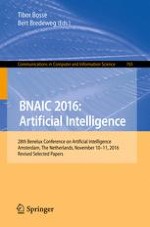This book contains a selection of the best papers that were presented at the 28th edition of the annual Benelux Conference on Artificial Intelligence, BNAIC 2016. The conference took place on November 10-11, 2016, in Hotel Casa 400 in Amsterdam. The conference was jointly organized by the University of Amsterdam and the Vrije Universiteit Amsterdam, under the auspices of the Benelux Association for Artificial Intelligence (BNVKI) and the Dutch Research School for Information and Knowledge Systems (SIKS). The objective of BNAIC is to promote and disseminate recent research developments in Artificial Intelligence, particularly within Belgium, Luxembourg and the Netherlands, although it does not exclude contributions from countries outside the Benelux.
The 13 contributions presented in this volume (8 regular papers, 4 student papers, and 1 demonstration paper) were carefully reviewed and selected from 93 submissions. They address various aspects of artificial intelligence such as natural language processing, agent technology, game theory, problem solving, machine learning, human-agent interaction, AI & education, and data analysis.
